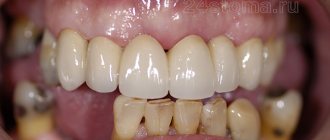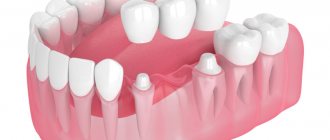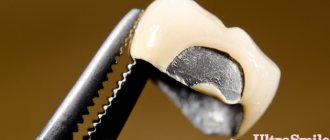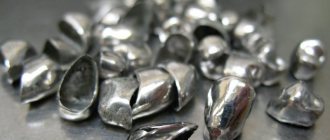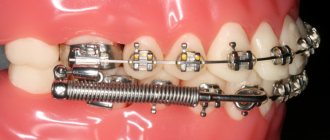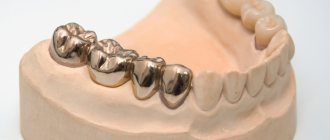From this article you will learn:
- does it hurt to put a crown,
- stages of prosthetics,
- how much does it cost to put crowns on teeth – prices 2021.
Making and installing a crown on a tooth is a complex procedure consisting of many stages. In this article we will talk about many subtle points that affect the aesthetics and service life of your crowns. These points relate to both mistakes when choosing the type of crowns by the patient himself, and mistakes made en masse by dentists at the stages of their manufacture.
For example, most of the complaints from patients about the quality of prosthetics relate mainly to 2 things. Firstly, poor aesthetics, and the fact that the crowns stand out against the background of neighboring teeth. Secondly, the quality of therapeutic preparation of teeth for crowns. The latter leads to complications - pain, suppuration, the need for re-treatment and even tooth extraction.
When is it recommended to get a crown?
These prostheses need to be installed in the following cases:
- when most of the tooth is affected by caries;
- severe destruction of the dental organ (more than 70%);
- the tooth is destroyed after injury, the root must be intact;
- external defects of teeth (hereditary or acquired), changes in their color when aesthetics suffer;
- enamel predisposition to pathological abrasion;
- loosening of teeth, which is the cause of periodontal disease (temporary dentures will make them more stable);
- when a bridge is installed, thanks to the crowns it is fixed to the supporting teeth;
- the presence of uneven edges on the tooth, which injure the mucous membrane.
But how to place a tooth if there is no root?
The main goals of prosthetics are to return the patient to the ability to chew food normally, restore the aesthetics of a smile, and prevent further tooth decay due to chewing overload. Here are 3 main ways to insert a tooth:
- removable prosthetics
- making a prosthesis from nylon, acrylic, silicone, Acry Free material; - bridge prosthetics
- the classic technique involves grinding two adjacent teeth with a defect, which will be used as supports for a prosthesis that replaces a lost tooth. It is also possible to install a bridge on implants; - installation of an implant
followed by loading with a crown.
Sometimes patients ask if it is possible to grow a tooth in any way without a prosthesis? Alas, no - if a tooth is removed or lost along with the root, then there is literally nothing to build up. The methods of tooth extension, which we also talked about, are effective only in cases where there is a root and some volume of the crown has survived.
Which material to choose?
Thanks to new developments, in modern dentistry there are several types of materials from which crowns are made. Let's consider the main ones:
- Metal ones are classic dentures that have been used for many years. Most often they are made of gold. The advantages of such products are strength, reliability and durability. They do not oxidize, have an abrasion coefficient almost like that of natural enamel, and do not damage opposing teeth. The main disadvantage is minimal aesthetics, which is why they are placed on invisible areas of the jaw.
- Metal-ceramic, combining the advantages of metal and ceramics. They have durability, strength and high aesthetic values. They cost less than all-ceramic ones. The disadvantage of these prostheses is the mandatory preparation of a large amount of living tissue before their installation, as well as the possibility of abrasion of the enamel on the opposite dental organs. A strip of black metal near the gum may also be visible if its edge is lowered or the product was not made accurately.
- Crowns that have the most aesthetic appearance are made from ceramic or porcelain. They are as similar as possible to natural teeth and retain their properties for a long time. However, ceramics are significantly fragile and cannot always withstand the load of chewing. For this reason, ceramic products are often placed on the front teeth. The main disadvantage of these crowns is their high price.
Crowns for the front teeth: photos before and after prosthetics, types of prostheses for the lower and upper jaw
Losing front teeth is considered a tragedy for most people. This makes it impossible to smile and be open with people. If earlier the process was irreversible, now everything is different. Modern medicine offers many possibilities for prosthetics of lost teeth. You need to focus not only on your taste, but also on considerations of practicality.
Front teeth should be beautiful
A beautiful smile is what people pay attention to first. Beautiful teeth are the key that opens many doors. Thanks to them, a person gains the favor of strangers. A beautiful smile is a ticket to achieving career heights and personal happiness. It is she who can melt even the hardest heart or make your counterpart respect you.
Crowns in the smile area
The need to install a crown arises if:
- The tooth located in the visible area is damaged. The undamaged parts are used to install future crowns. When such parts are not available, a pin is used.
- For medical reasons, one of the incisors or fangs had to be removed. In this case, a so-called bridge is placed - a prosthesis on healthy teeth, which consists of several combined crowns.
- There are malocclusions.
The main difficulty with prosthetics of incisors and canines is that they will be visible to others. This obliges the doctor to perform high-quality work not only from a practical, but also from an aesthetic point of view.
Requirements are also imposed on the patient: the desire to save on materials and the quality of work of the prosthetist dentist can result in an unattractive smile.
As a result, you will either have to redo all the work again, or stop smiling in public (we recommend reading: how to smile with teeth and without them?).
What is the best material for dentures? All materials for prosthetics of the visible row of teeth are divided into several types: metal, metal-ceramics, metal-free ceramics. The pros and cons of dentures made from different materials are shown in the table below:
| Crown material for front teeth | pros | Minuses |
| Metal | Affordable prices, long service life | Unaesthetic appearance, high probability of allergic reactions |
| Metal ceramics with precious metals | Appearance is close to natural, durable, safe for people prone to allergic reactions | High prices |
| Metal ceramics with conventional metals | Includes the advantages of products made from precious metals, but has an acceptable cost | There are risks of allergic and galvanic reactions |
| Porcelain | Beautiful and safe | Fragile, expensive |
| Zirconium dioxide | Beautiful appearance, low risk of complications, long-term operation | The cost is high |
| Alumina | Maximum naturalness and biocompatibility, reasonable prices | Fragile, will not last long |
| Metal-plastic | Cheapness | Fragile and short-lived |
Metal
Prices for metal crowns range from 800 rubles to 25,000. The variation in cost is due to the fact that different materials are used for their manufacture: ordinary metals and precious ones. The first ones cannot boast of an aesthetic appearance, but they will surprise you with affordable prices.
INTERESTING: Why do rappers need gold plates on their teeth?
Metal crowns are in demand among older people, the reason for this is not only their economy. Previously, there was no alternative to such crowns, and everything new is perceived with hostility.
Metal crowns are capricious. If you once placed a crown made of gold, then when replacing it in the future you will have to make structures from this material. Otherwise, galvanic reactions are possible: tingling and metallic taste in the mouth. It is better not to place metal crowns on your front teeth.
Manufacturing
Crowns are made using prepared plaster models. Metal, metal-ceramics and ceramics can be used as the manufactured material.
Manufacturing is quite labor-intensive and time-consuming, so while the dental technician is working on their creation, the patient is put on temporary plastic products. This way, the aesthetic appearance of the ground teeth is restored, and they are protected from external influences and infection. These dentures, in addition to protecting teeth, also allow them to be fully used when chewing.
Grinding of teeth for installation on their crowns
Grinding of teeth is called preparation. This procedure is performed using a drill into which a diamond bur is inserted. This way the tooth can be given the desired shape.
When grinding living teeth, the procedure is painful, so the patient is given anesthesia before it is performed. If you need to grind a pulpless tooth, anesthesia is not always used, but if you need to move the gums, it is better to do it.
The orthodontist needs to grind the tissue of the dental organ, a layer of which will be equal to the thickness of the prosthesis. Depending on the crown used, 1.5-2.5 millimeters of dental tissue can be removed from all sides of the dental organ. When fastening cast structures, less grinding will be required, and if products made of ceramics or cermets are installed, more grinding will be required.
The ground tooth forms a stump where the crown will later be attached.
How is the crown of a tooth restored?
The crown part of a tooth can be destroyed in different ways in different cases, which is why it is restored in different ways. To do this, either a stump inlay is installed in the tooth, or a pin is placed, and this does not in any way affect the appearance of the tooth.
A pin is a highly durable rod that is screwed into the root canal after it is filled. It plays the role of a basis for attaching the filling material. Then the tooth is built up and ground down for a prosthesis.
Using a stump inlay, you can make a very reliable restoration of a dental organ that will last a long time. It is made in a laboratory from a special metal that is non-toxic. The inlay consists of a coronal and root part. The root one is attached in the root canal of the tooth, and the coronal one has a look that is ready for attaching a crown to it.
The first stage of installation is preparatory
Before installing a crown, the dentist must carefully examine the patient's oral cavity; if necessary, an x-ray can be taken. Based on the examination results, a treatment plan is drawn up and the necessary procedures are recommended. It is also important to examine the patient for contraindications and allergies to any material.
The doctor and the patient select the most suitable type of crown. The timing of when the prostheses will be manufactured and installed, as well as the cost of treatment, is clarified.
If there are diseases of the gums and teeth in the oral cavity, they are cured.
Next, you need to prepare the tooth itself for installation, which is one of the main points of prosthetics. In this case, the doctor does the following:
- Removes the nerve from the tooth and grinds it down. It is important to grind a layer of the tooth that will correspond to the thickness of the prosthesis. When attaching a crown to anterior units with one root, removal of the nerve is necessary, because during grinding a pulp burn may occur. Depulping a multi-rooted tooth is not necessary, because the risk of burns in such a situation is minimal.
- Treats teeth affected by caries. Performs filling of canals. Cleans teeth from tartar and plaque.
- If the dental organ is severely damaged, it is depulped, the canals are filled and the coronal part is recreated with a filling compound.
- When attaching a crown to a living tooth, anesthesia must be used.
- If there is a filling on the supporting tooth, it is replaced with a new one.
After preparing the teeth for attaching the prosthesis, impressions are taken from them, which will be used to make crowns in the laboratory.
Laboratory (second) stage of installation
Using impressions taken from prepared dental units, plaster models of dental organs are made in the laboratory. This way, the dental technician gets an exact plaster copy of the patient’s teeth, maximally reflecting all their features. With the help of these models, further production is carried out.
Fitting and fastening - the third stage of installation
Before the crown is installed and even before the completion of manufacturing work, the first fitting of the prosthesis is performed. They check that it sits on the stump accurately and firmly.
Next, adjustments are made to the product if necessary and it continues to be formed in the laboratory. If metal-ceramics is used as the material being manufactured, it is necessary to coat the metal frame with an aesthetically attractive ceramic composition.
After completion, the prosthesis is fixed with a temporary composition, which allows you to evaluate the comfort of wearing the prosthesis, the possibility of allergic reactions, and eliminate the possibility that it will interfere with the connection with opposing teeth. The reaction of the dental units and neighboring tissues to the presence of a new element in the oral cavity is checked.
At this time, dental canal filling defects, inflammation or severe pain may appear.
The most common defect is the following: overbite, which causes the prosthesis to fit loosely on the neck of the tooth, injuring the gums and causing bleeding.
If there are such complications, measures should be taken to eliminate them.
Temporary dentures are worn from two weeks to a month. If the patient has no complaints, they are removed, the dental unit is cleaned and the permanent product is secured with permanent cement. Then the crown is irradiated with a special lamp, which promotes hardening of the cement. All excess cement is carefully removed.
Note: You can chew on the tooth where the crown was placed after a couple of hours, and the maximum load can be placed on it after one day.
Does it hurt to insert teeth?
Typically, patients are interested not only in how a crown is placed on a tooth, but also how painful it is. The most unpleasant stages here, of course, are preparing teeth for prosthetics (i.e., treating them, filling root canals), and sometimes also the process of taking impressions. If already dead teeth are used for crowns, then turning them is completely painless and does not even require anesthesia. If living teeth are ground down, a local anesthetic is first injected.
The only painful moment that I myself (being a dentist) have personally experienced is when, when taking an impression, the doctor performs gum retraction. Retraction refers to the widening and deepening of the gingival sulcus, which is accompanied by a small degree of separation of the soft gum tissue from the tooth. This is done in order to make a more accurate impression of the neck of the tooth, and it is better to do this immediately under anesthesia.
Cases in which crown removal is necessary
The need to remove the crown may be due to the following reasons:
- The tooth was poorly prepared for installation of the prosthesis. Statistics show that 60% of cases of dental canal filling are carried out with errors. This serves as a prerequisite for the development of inflammation, and tooth treatment leads to the need to remove the structure.
- Error during construction. If the product distorts the bite, does not fit tightly around the neck, or causes physical or aesthetic problems, it is removed.
- Planned replacement. At the end of its service life (usually 10-15 years), the prosthesis is replaced.
- Damage to the structure, the appearance of cracks or holes on it from washed cement, requires urgent replacement of the product.
- The occurrence of complications.
How to remove dental crowns -
Unfortunately, we must also note the fact that sometimes situations arise when the crown needs to be removed. For crown removal, the price for 2021 will be about 1000 rubles per unit. The need to remove the crown may be due to the following reasons...
- With poor preparation of the tooth for a crown - according to statistics, in 60-70% of cases, the root canals of the teeth are filled poorly, which leads to the development of inflammation and the need for re-treatment or removal of the tooth. You can find out more about poor-quality preparation of teeth for prosthetics, what this leads to, and what to do about it here .
- With manufacturing errors - for example, the crown did not fit tightly around the neck of the tooth, and therefore, within days, the destruction of the tooth tissue began. Metal-ceramics or metal-free ceramics could chip a large fragment of the ceramic mass, which may not be repairable and require replacement of the crown (24stoma.ru).
- Scheduled replacement of crowns is necessary - all crowns have their own service life, and they will have to be changed periodically. It should be noted that high-quality modern crowns can last 8-10 years, or even more.
Removing crowns: video
And here the question always arises: does it hurt to remove the crown... It can indeed be a little painful, and therefore the procedure is performed under local anesthesia. Removing cermets, for example, is very difficult. The crown is sawed using special discs and burs, and cases of damage to the gums next to the tooth are not uncommon. We hope that the article on the topic: How to put crowns on teeth was useful to you!
Sources:
1. Personal experience as a dentist, 2. “Orthopedic dentistry. Textbook" (Trezubov V.N.), 3. National Library of Medicine (USA), 4. "Orthopedic treatment with fixed prostheses" (Rozenstiel S.F.), 5. "Crowns and bridges in orthopedic dentistry" (Smith B .).
Removal methods
Removing the product is quite difficult, especially if you need to keep it intact in order to reinstall it.
If removal is due to a broken structure, it is better to cut it with special tools.
If it is necessary to preserve the prosthesis, the following is used to remove it:
- Crown removers (the most common are Kopp hooks) are special tools in the form of flat hooks that can be automatic or manual. With their help, the prosthesis is removed at the part where it connects to the tooth.
- The forceps securely grasp the prosthesis with its jaws and remove it from the base.
- Ultrasonic installations. Ultrasound waves can destroy the adhesive cement, after which the prosthesis can be easily removed.
- Pneumatic tools, the use of which also contributes to the destruction of cement and facilitates the removal of the crown.
Features of care
Zirconium dentures do not require special care. The set of procedures does not differ from standard daily care for natural teeth:
- regular brushing with toothpaste without solid particles (containing abrasives);
- preference should be given to brushes designed for cleaning dentures;
- rinsing the mouth after eating;
- use of special superfloss threads.
The high strength of zirconium products allows you to consume products without any restrictions. Apples, carrots, hard chocolate and similar foods can be safely bitten with new teeth. However, you should not chop nuts, ice, or candy with the help of dentures.
A prerequisite for care is to visit the dentist at least once a year. Following the recommendations extends the life of artificial teeth, eliminating side effects such as cracks and chips.
What are the complications?
Let's consider complications that can appear after the installation of crowns:
- Strong pressure from the product on soft tissue disrupts blood circulation and contributes to the formation of bedsores. In this case, the soft mucous membrane can die off at the point of contact between the gums and the crown. This is how prosthetic stomatitis can develop.
- Damage to supporting dental units by caries. Poor cleaning of the oral cavity or poor preparation of the dental organs for the installation of a prosthesis leads to the accumulation of food particles under the crown, where bacteria that cause disease develop.
- An allergy to the metals that make up the prosthesis may not appear immediately after installation of the structure, but after some time. There is a burning sensation in the mouth, dryness, and inflammation occurs.
- Galvanic syndrome can be caused by the presence of various metals in the mouth. The result is the formation of an electric current, which enhances oxidative reactions. At the same time, the patient feels a metallic taste in the mouth, there may be a general malaise, a headache, the structure and neighboring dental organs may change color.
Each of these complications requires a quick reaction and a visit to the attending physician, otherwise you may lose the supporting tooth. The doctor will most likely remove the crown, perform treatment and install a new one.
In what cases is the installation of a stump tab indicated?
If a tooth is destroyed by 70% or more, its restoration with filling material using a pin becomes impractical - such a design cannot withstand loads. In this case, there is a threat of fracture of the root itself. This leads to tooth extraction, which means prosthetics become more complicated. Therefore, if there is practically nothing left except the root, the best option would be to install a stump tab. At the same time, the edge of the tooth must still protrude above the gum, on which it can be fixed, otherwise it will be impossible to install an artificial stump.
Important! You can use a stump tab only if there is a healthy root.
The inlay is also used if the tooth is being prepared as a support tooth for a bridge or splinting structure - this increases their reliability.
It is possible to use this technique for pathological tooth wear, as well as anomalies in the development of anterior teeth in adults that cannot be eliminated by orthodontic methods.
The most interesting questions for patients
Question
— Does it hurt to install a crown?
Answer
— Denture installation can cause discomfort, like any other dental procedure. The greatest number of unpleasant sensations occurs during the preparation stage, which includes drilling, grinding of dental organs, cleaning and filling of canals. But the fact that the crown is generally attached to pulpless teeth minimizes the likelihood of pain. If live teeth are ground, anesthesia is used. And the actual attachment of the crown to the stump is completely painless.
Question
— What is the duration of the procedure?
Answer
— Installation has several stages. To prepare your teeth, you need to visit the dentist one to two times, and sometimes more. The duration of each visit depends on which teeth are planned to receive a crown and their condition. It may take several weeks to make a crown. The prosthesis is placed on temporary cement for a period of 2 to 4 weeks. Then it is finally attached. In this case, the total time spent on installing a crown can be from 1 to 2 months, and sometimes more.
Question
— Are crowns placed on living teeth?
Answer
— For living multi-rooted teeth, the condition of which does not require depulpation, a crown is allowed. They can also be placed when installing a bridge, when crowns are attached to ground healthy teeth.
Preparation for prosthetics
The process of preparing for prosthetics using a dental crown consists of several stages.
- Assessment of the clinical picture and condition of the patient’s oral cavity. At this stage, the scope of future intervention is discussed, the type of crown is determined and a treatment plan is drawn up.
- If necessary, treatment of inflammatory diseases of the gums, periodontal disease, and caries is carried out. All old fillings on supporting teeth must be replaced with new ones.
- If the use of metal-ceramics is intended, then tooth depulpation is most often carried out in order to prevent inflammatory lesions.
- Tooth preparation is the removal of hard tissue of a certain thickness using instruments. For metal structures, removal of 0.3 mm of enamel and dentin is sufficient, and when using metal-ceramics, the ground layer can reach 2 mm. In addition, for more reliable fixation of the prosthesis, it is necessary to prepare the teeth with an indentation.
- After the teeth are treated and prepared, impressions are made using a special paste, on the basis of which dental crowns are made in a dental laboratory.
- After making the prosthesis, several fittings are carried out to determine the accuracy of the construction, its comfort and consistency in color and structure with the rest of the teeth. Very often, the finished crown is secured with temporary cement for up to 3 months. This is necessary so that the patient is finally convinced of its comfort and proper restoration of chewing function.
Reviews
Elena, 29 years old
After building up two front incisors, one of them fell off completely, and only half remained on the other. Now I’m wondering whether to put crowns on them, or is it better to have them built up again by another specialist?
Egor, 45 years old
I was very worried after attaching the crowns with permanent cement. I had already put crowns on myself twice before and the doctor always pressed hard on the prosthesis when putting it on, and the last time he just held it. I panicked that it would quickly disappear. I asked another specialist - he explained that after putting the prosthesis on the cement, I treat it with a special lamp, which leads to hardening, so strong pressure is not required. I've been wearing crowns for over a month now. Everything suits me.
Anton, 32 years old
Placed zirconium crowns on 3 front incisors. I spent a lot. But a week later one of them fell out. I went to the doctor, he said that there was temporary cement and installed it again. Then, one by one, with an interval of two days, the remaining two crowns fell out. Again I went to the doctor twice and twice he changed the temporary cement, which is not permanent. I can’t understand why he couldn’t immediately attach all three to me with permanent cement when I came in for the first time? And what’s also annoying is that after the crowns were re-installed, biting on these teeth became somehow not so much painful, but rather scary. And this fear still does not go away.
Polina, 31 years old
After installing the crown, I feel that it is bothering me and does not connect to the opposite tooth properly. And my gums still hurt a little. Although during the fitting everything was fine. What to do in such a situation? Will I have to remove the prosthesis?
Prices at Doctor Zhuravlev Clinic
| Plastic crown (temporary) | PC. | 1000 rub. |
| Solid crown | PC. | 3600 rub. |
| Metal-ceramic crown | PC. | 6000 rub. |
| Metal-ceramic crown on an implant | PC. | 15,000 rub. |
| Zirconium oxide crown for implant | PC. | 16,000 rub. |
| Crown based on zirconium oxide | PC. | 13000 rub. |
| Endocrown | PC. | 12000 rub. |
| Pressed ceramic crown | PC. | 14,000 rub. |
| Stump tab | PC. | 3600 rub. |
